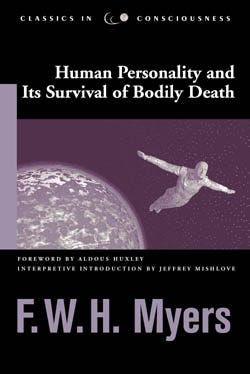
This article is the latest in a series on the theme of whether we can find a new mythology, a common visionary story, to unite humanity in an attempt to solve the world’s problems (For a guide to the whole series, see under Mythology near the bottom of the Blog Index page.) In the previous article I discussed the relevant forward–looking psychology in general terms, the essential point being that we should be searching for a spiritual psychology, not one derived from scientific materialism. Here I’m going to look at one specific attempt to formulate such a psychology, Irreducible Mind: Toward a Psychology for the 21st Century¹. This is by a team of writers under the general editorship of Edward F. Kelly. It’s a long and dense read, over 600 pages, but well worth the effort, if you have the time.
Although the book is looking towards the future, it contains some relevant history. It is dedicated to Frederic Myers, described as “a neglected genius of scientific psychology”, and to Ian Stevenson and Michael Murphy, “two modern bearers of his intellectual legacy”².
Myers was one of the founders of the Society for Psychical Research (SPR) in Great Britain. His most famous work is Human Personality and Its Survival of Bodily Death³ which, in the authors’ opinion, summarises “the most systematic, comprehensive, and determined empirical assault on the mind-body problem ever carried out… during the entire long history of psychology”. William James, famous American psychologist, friend and colleague of Myers, said that “through him for the first time, psychologists are in possession of their full material, and mental phenomena are set down in an adequate inventory”. Gardner Murphy praised “the heroic accumulation of data and amazing integration which the work represents”. H. F. Ellenberger described the book as “an unparalleled collection of source material on the topics of somnambulism, hypnosis, hysteria, dual personality, and parapsychological phenomena… containing a complete theory of the unconscious mind, with its regressive, creative, and mythopoetic functions”⁴. All this suggests that the book is well worth reading, and is available free online⁵.
Kelly’s book continues in the tradition of Myers, James (and also Pierre Janet), opposing scientific materialism: “We also identify a variety of specific empirical phenomena, and a variety of critical aspects of human mental life, that appear to resist or defy understanding in terms of the currently prevailing physicalist conceptual framework” (Pxxix).
Some of these phenomena are: ESP and parapsychology, hypnosis and Mesmerism, genius, savant syndrome and prodigious memory, memory and consciousness surviving bodily death, reincarnation (and birthmarks and birth defects in relation to this), memory as not being a brain function, secondary centres of consciousness, a deeper self beyond the ego (called by Myers the Subliminal Self), mystical and conversion experiences, near-death and out-of-body experiences, dreams, hallucinations, apparitions and visions, trance, possession, ecstasy, voodoo death, faith healing, placebo and nocebo effects, psychosomatic phenomena, automatic writing, artistic creativity, mediumship, and invisible environments interrelated with the one we know directly.
The conclusions of the authors, if the evidence is considered objectively and without preconceptions, are that “physicalism must be false” (p37), and that “consciousness (is) somehow at the root of all” (p44, thus adopting the understanding of all religions, and the philosophy of idealism). The book comes as close as it is possible to do to refute scientific materialism. Advocates of the latter tend either to dismiss the above phenomena as illusions, because they consider them to be against the laws of nature or, perhaps more commonly, simply ignore their existence. It should be obvious, however, that “scientific knowledge (will) advance qualitatively only when scientists address all phenomena, and particularly those that do not readily fit into current views” (p63). Myers “believed that the challenge does not end but begins precisely when one comes up against contradictory findings, position, or theories, and that breakthroughs occur when one continues to work with conflicting data and ideas until a new picture emerges that can put conflicts and paradoxes in a new light or a larger perspective” (p64).
Also worth reading, by the same authors, is Beyond Physicalism: Toward Reconciliation of Science and Spirituality⁶. In my opinion these two books are the Bible of new-paradigm science and psychology, thus essential foundation-stones in a search for a new spiritual mythology.
This article is the last in the current series, searching for a common worldview (mythology) to unite humanity. So here is a closing thought. The quantum physics revolution is frequently seen as indicating the existence of a hidden reality (or hidden realities) out of which the material world emerges. Myers immediately tuned into this development, and appreciated its significance. I especially like this pithy comment which exposes the contradiction at the heart of scientific materialism: “Science, while perpetually denying an unseen world, is perpetually revealing it” (quoted in Kelly, p69).
In the next series, I’m going to turn to a study of the old myths, to see whether they can still be relevant to modern life.

================================================================================================
Footnotes:
1. Rowman & Littlefield, 2010
2. Stevenson is well known for his research into children’s memories of past lives, described in Twenty Cases Suggestive of Reincarnation and Where Biology and Reincarnation Intersect. I have discussed him in an earlier article. Murphy was a co-founder of the Esalen Institute which, as American readers will know, has been at the forefront of the exploration of progressive psychology for decades.
3. Longmans, Green, & Co., 1903
4. all quotes Kelly, Pxxix
5.https://archive.org/details/humanpersonality01myeruoft/page/n4/mode/2up
6. Rowman & Littlefield, 2015